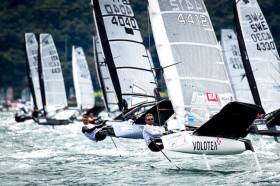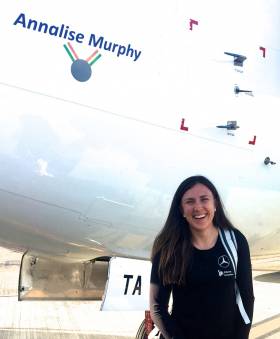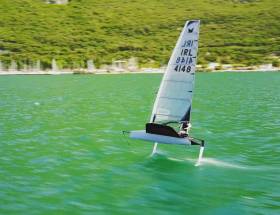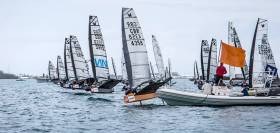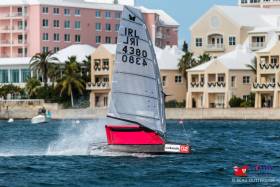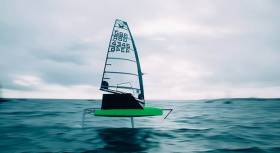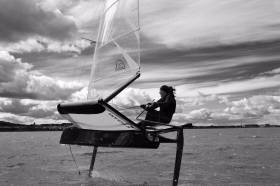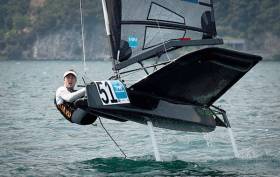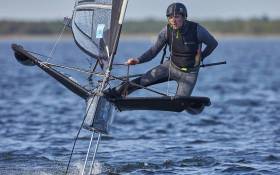Displaying items by tag: moth
Annalise & Rory Are Fluttering Best of Irish in Moth Worlds
The fleet in the International Moth Worlds 2017 at Lake Garda have finally boiled down to “only” 220 boats after some early estimates reckoned they should be expecting between 240 and 250 writes W M Nixon.
But as it is, the 220 boats and the volatile weather of mid-Europe in high summer have seen one day lost with no wind at all since the championship proper got going on Tuesday morning, while other races have seen conditions fluctuating wildly with the occasional thunderstorm to add to the fun.
Out of it all has come the news that once the national representation gets over a certain size, it’s described as “a flutter of Moths”. And apparently the word is that the Irish squad have qualified as “a flutter”.
Come to that, you could take a useful flutter on Annalise Murphy becoming the new Women’s World Champion, as she’s currently showing well clear ahead. That said, anyone who claims to understand how all the different fleets are being given meaningful overall placings clearly hasn’t been studying the results at all….
As for the rest of the Irish flutter, Annalise’s Olympic coach Rory Fitzpatrick has also been showing well, with a first and second in there on his scorecard. But in a fleet of this size and complexity, all sorts of final results are possible when this totally international event eventually concludes.
It’s not every day you get to fly on a jetliner named in your honour writes W M Nixon. But then, not everyone has won Ireland a Silver Medal in the Olympics. Even at that, today’s busy flight schedules are so hectic that the chances of happening to fly on your personally-named plane are still slim enough.
But this weekend, everything came right for Annalise Murphy as she boarded ASL Airlines B737 “Annalise Murphy” at Dublin Airport, heading for Verona and the Moth Worlds which start on Tuesday at Malcesine on Lake Garda.
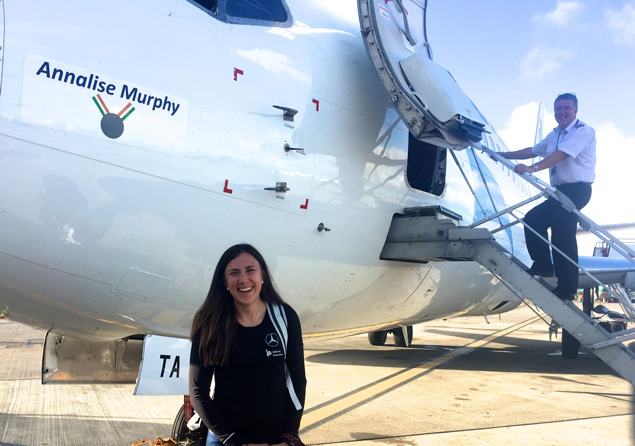 For once, she wasn’t going to be at the helm. Annalise Murphy and “her” plane as Captain Demie Ryan of Blackrock, Co Dublin goes aboard to fly her to Verona. Photo: Con Murphy
For once, she wasn’t going to be at the helm. Annalise Murphy and “her” plane as Captain Demie Ryan of Blackrock, Co Dublin goes aboard to fly her to Verona. Photo: Con Murphy
With last month’s America’s Cup and its focus on racing with foils now analysed down to the finest details, the Worlds for the foiling Moths couldn’t be staged at a more appropriate time. Several of the rock stars from the big one in Bermuda will be very much in the action on Lake Garda, including winner Peter Burling of New Zealand, and Australia’s Nathan Otteridge of the highly-rated Swedish Artemis challenge.
There are many other Olympic stars taking part in addition to Annalise, and the Irish challenge in the fleet of 240 is further strengthened by the participation of five other Irish Moth sailors, including her coach Rory Fitzpatrick, who is certainly no slouch when it comes to his own performance in foiling Moths – he emerged as champion at the Cork Dinghyfest three weeks ago. The week’s racing starts tomorrow (Monday) with the non-championship “Banging the Corner” dash-for-cash event, then after that it’s down to the serious stuff.
With the Moth World Championships fast approaching with 240 boats expected in Lake Garda, there's been plenty of foiling practise going on at the Italian lake this week.
The championships has attracted several Irish boats, including national champion Rory Fitzpatrick who sails under the burgee of both the Royal Irish and National Yacht Club, and the Irish lads will be mixing it up with plenty from the ranks of the America's Cup and Olympic circuit.
Royal Cork's David Kenefick is in Garda and has just finished its foiling week, a World Championships pre-cursor in tenth overall in a new boat he is preparing for the Worlds event.
The former Cork Harbour Figaro competitor was lying eighth before the last day but unfortunately, he broke his tiller extension just before the last two races so was unable to hike out.
Also lining up for Ireland are Graeme Grant (ISA), Neil O'Toole from the National Yacht Club, Jim Devlin from the Royal St. George, Alistair Kissane from Howth Yacht Club. There are two Irish youth entries from RStGYCs Adam Hyland and HYC's Ewan MacMahon. Annalise Murphy will compete in the ladies division.
Of extra Irish interest is the fact that both Fitzpatrick and Hyland will be sailing Moths that have been designed and built in Ireland by County Wicklow's Chris Allen under the brand name of Voodoo moths, as previously reported by Afloat.ie
There will also be an Austrian Voodoo sailing and a number of Australian and other international boats using Voodoo foils, designed and built by Allen in Bray.
Chris Allen designed moths are also being built under licence in the UK by Atomik boats, and there will be a number of these sailing at the Worlds.
More on the Moth Worlds at the beautiful Malcesine venue here
Sailor of the Year Annalise Murphy Leads the Charge for Moth Womens' World Championship Honours
Afloat.ie's Sailor of the Year, Annalise Murphy, the 2016 Laser Radial Olympic Silver Medallist and 2014 Women's Moth World Champion, leads the charge in the growing women's fleet of this year's Moth World Championships scheduled for Malcesine, Italy.
Murphy's Rio performance was rewarded at home last Friday in a packed gathering at the RDS, Dublin. See photos and report here.
Murphy will be up against reigning champion Wakako Tabata (JPN) and 2013 Women's Champion Emma Gravare (SWE). With 6 months remaining, the 2017 Moth Worlds has already attracted a record number of entrants. Earlybird entries closed on Tuesday with 190 competitors from 25 countries registered for the event to be held at the Fraglia vela Malcesine on Lake Garda in late July.
The record line–up features a daunting who's who of top sailors.
At the top of the list is the Olympic Laser shoot out, with reigning Moth World Champion, 2008 Gold Medallist and Artemis Racing helmsman Paul Goodison (GBR) going up against 2012 Gold Medallist and Oracle Team USA tactician Tom Slingsby (AUS) and 2016 Gold Medallist Tom Burton (AUS).
Among the past champions, 2009 & 2013 Moth World Champion Bora Gulari (USA) makes a comeback to the class after taking time out to compete in the Nacra 17 at the Rio Olympics. Also making a return after Olympic and Americas Cup commitments, dual medallist Iain Jensen (AUS) will be looking to improve on his top 10 result in 2015.
Rory's Irish Moth in Top Ten At Bermuda's International Moth Regatta
Moth Sailor Rory Fitzpatrick from Dun Laoghaire enjoyed a great end fo a great season in his foiling dinghy when he placed tenth overall at the MS Amlin International Moth Regatta in Bermuda last week. The National Yacht Club sailor chalked up the top score against some of the best of the international foiling fleet. The regatta attracted a field of 50 Mothists from 10 nations. Fitzpatrick adds the result to his fifth overall achieved at the Euro champs in France in July.
England's Rob Greenhalgh is a hard man to bet against when there's money on the line. Just ask Chris Rashley or Dylan Fletcher-Scott.
For the second consecutive year, Greenhalgh came through when it mattered most and successfully defended the MS Amlin International Moth Regatta hosted by the Royal Bermuda Yacht Club.
Last year Greenhalgh entered the final day trailing Rashley by 1 point. He then went out and won four races to score an 8-point victory.
MS Amlin International Moth Regatta Final Provisional Standings
(After 12 races, including two discards)
1. Rob Greenhalgh, GBR, 22 points
2. Dylan Fletcher-Scott, GBR, 25
3. David Hivey, GBR, 34
4. Ben Paton, GBR, 61.5
5. James McMillan, GBR, 64
6. Dan Ward, GBR, 75
7. Jonathan Heathcote, GBR, 75
8. Simon Hiscocks, GBR, 76
9. Stefano Rizzi, ITA, 79
10. Rory Fitzpatrick, IRL, 92
Annalise Murphy & Her Foiling Moth At Full Speed in Bermuda (VIDEO)
Annalise Murphy picked up another well deserved reward at the weekend when she shared the REHAB Sportsperson of the Year Award at the weekend. The Dun Laoghaire Olympic Silver medalist couldn't be there in person to pick her award at the Dublin ceremony because as soon as she arrived home her medal winning Laser she jetted off to Bermuda to sail her foiling Moth where there's been plenty of action over the last few days. Just look at Annalise in the pink Moth go...
Howth Yacht Club's Kissane In Top Half of UK Moth Fleet
Alistair Kissane of Howth Yacht Club has finished in the top half of the UK's Moth Championships sailed at Portland Harbour. Kissane, who finished 34th, was one of two Irish in the 73–boat fleet. Royal St. George's Jim Devlin was 52nd. Results are here.
The wind just didn't play ball on the final day, with the odd gust reaching 7 knots across Portland Harbour, but more commonly 3-4 knots and much less. At 1pm the race team called time and raised AP over A to abandon racing for the day. This means the results at the end of Monday stand and Robert Greenhalgh has been crowned the UK International Moth class champion for 2016.
At the prize giving Robert thanked the Race Team, all the staff at the WPNSA, the UK Moth Class Association for putting all the work in ahead of the event and the sponsors; VRsport.tv, blueteq, Brand Identity, Ronstan and Noble Marine.
The podium was completed by David Hivey in second and Dylan Fletcher in third.
The next major event for the International Moth Class is the MS Amlin Moth Regatta in Bermuda from 2-9 December. In 2017 the World Championships are being held in Malcesine on Lake Garda from 23-29 July.
Final top five
1. Robert Greenhalgh, GBR, 8.0
2. David Hivey, GBR, 12.0
3. Dylan Fletcher, GBR, 18.0
4. Mike Lennon, GBR, 31.0
5. Jason Belben, GBR, 32.0
The President of the governing body of International Sailing has spoken about the possibility of a foiling boat in the OIympic Sailing line–up for Tokyo 2020. In a far reaching interview with Scuttlebutt's Craig Lewick, World Sailing's Carlo Croce also says that sailing is one of six sports under review for the 2020 Games. It looks certain therefore that there will be changes in the sailing classes, something World Sailing, according to Croce, is hoping to keep to a minimum as the International Olympic Committee (IOC) looks for 'spectacular' events.
'I think in November we will be able to announce good news to the Council, but at the moment we’re still confidential because the IOC has not yet formally decided. Maybe kiteboard, maybe foiling boat… I don’t know. Perhaps an old hobby of mine – a long distance race with very simple and basic one design boats with no extreme equipment', Croce said.
The choice of a foiling boat, such as the Moth class, might be looked on favourably by Ireland as Olympic silver medalist Annalise Murphy, in the Laser Radial class, is also a keen foiling dinghy sailor. Annalise has already finished second in the Women's world Moth championships, a pioneering international foiling class with 15 boats sailing in Ireland.
'We decided to ask our members to vote for what we call the unlock vote, which meant we had to unlock the decision taken four years ago to keep the same Olympic events from the 2016 Games to the 2020 Games. We were pushed hard by the IOC to move forward to a more spectacular program, and they just give you – very quickly – two figures: 10,500 athletes in Rio and in London. This is the number they don’t want to change. There will be five new sports in Tokyo and six current sports under review, not for pushing them out, but to look what they can do for improving, and sailing is amongst the six' said Croce.
Croce also told Scuttlebutt 'We could pick up one man and a girl and put them in an offshore boat… just a personal thought. I am completely convinced we’d find someone who can find provide the boats to the Olympics free of charge. It could also be a way for people competing in a dinghy class to also participate in the offshore race and compete for two medals, which our sport never had. That could be interesting'.
But nothing is decided. It’s not me who will decide; it will be the Council. Certainly there will be changes, but what I want to really say is we will do absolutely the minimum changes we can not to have people throwing away all of their boats and our member nations being in trouble. So the changes yes, but just the minimum we need to. Our member nations have to design a program of four years, so we need to be quick.
Read the full interview on Scuttlebutt here.
Annalise Murphy will be given a civic reception tomorrow in Dun Laoghaire. Details here.
Royal Cork's David Kenefick has just finished foiling week on Italy's Lake Garda sailing his Full Irish Moth. Kenefick is keeping an eye on the Italian venue given it will host next year's World Championships in 2017 where a fleet of 200 is expected.
The Crosshaven sailor finished 19th out of 43 which is something of a comeback after breaking his rig at the Europeans and missed two days racing earlier this month in France.
'I'm happy as I've only being racing the Moth a few months, with this being my first full regatta', Kenefick told Afloat.ie
'I've a few improvements to make to the boat including a bow sprit and a new foil', he added.
The National Yacht Club's Rory Fitzpatrick scored an impressive fifth overall at the Moth European Championships at large natural freshwater lake in Bordeaux, France.
In a clean sweep of podium places for British sailors, Mike Lennon was crowned 2016 European Champion. Three other Irish sailors competed in the 73–boat fleet. Alistair Kissane of Howth was 26th, club mate Neil O'Toole was 56th and David Kenefick of Royal Cork was 66th.
Results are here


























